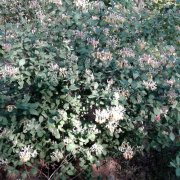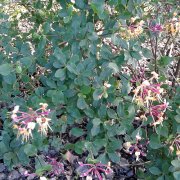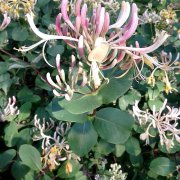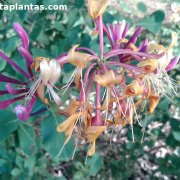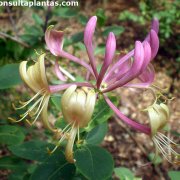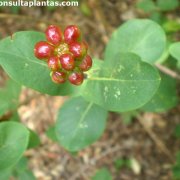Care of the climbing plant Lonicera etrusca or Etruscan honeysuckle |
|
The genus Lonicera, family Caprifoliaceae, comprises 100 species of shrubs and climbing plants native to the Northern Hemisphere. Some species are: Lonicera etrusca, Lonicera implexa, Lonicera periclymemum, Lonicera caprifolia, Lonicera sempervirens, Lonicera nitida, Lonicera japonica, Lonicera caerulea. Common name: Etruscan honeysuckle. This species is native to southern Europe. They are deciduous climbing shrubs that reach 4 meters (13.12 feet) in height. The leaves are elliptical, blue-green in color and grow opposite around the stem. The flowers are highly scented, tubular in shape and yellowish-white petals (pink on the outside). They bloom from mid-spring to mid-summer. The fruits are quite decorative red berries. Etruscan honeysuckle is used to cover walls and pergolas (it needs supports) and in large pots for patios and terraces. Lonicera etrusca prefers a semi-shadow exposure avoiding direct sun in the central hours of the day; in a shade exposure it will bloom less. Etruscan honeysuckle prefers a well-drained and slightly alkaline soil. Water regularly so that the substrate does not dry out completely. Lonicera etrusca does not resist flooding or prolonged drought. Fertilize with humus or compost in spring and fall. Intensively prune stems that are too long or those that have lost their leaves. Lonicera etrusca can be pruned after flowering to maintain a compact appearance. Etruscan honeysuckle is a quite resistant plant to the usual pests and diseases. Lonicera etrusca propagates from seeds sown in spring or by cuttings set to root in moist, sandy substrate in early spring or mid-summer. |
Images of the climbing plant Lonicera etrusca or Etruscan honeysuckle |
Find plants
Lonicera etrusca or Etruscan honeysuckle | Care and Growing
© 2025 FavThemes
